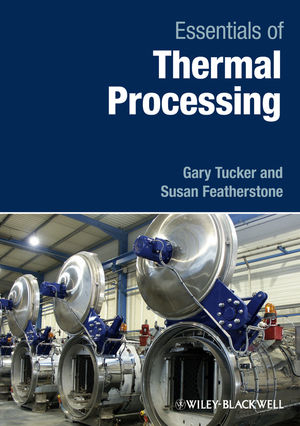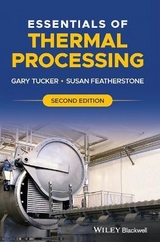
Essentials of Thermal Processing
Wiley-Blackwell (an imprint of John Wiley & Sons Ltd) (Verlag)
978-1-4051-9058-9 (ISBN)
- Titel ist leider vergriffen;
keine Neuauflage - Artikel merken
Thermal processing remains the most important method of food preservation in use today, and the scale of the industry is immense. The large scale of these production operations makes it more important than ever that the process is performed perfectly every time: failure will lead to product deterioration and loss of sales at best, and at worst to serious illness or death. This volume is a definitive modern-day reference for all those involved in thermal processing. It covers all of the essential information regarding the preservation of food products by heat. It includes all types of food product, from those high in acid and given a mild heat process to the low-acid sterilised foods that require a full botulinum cook. Different chapters deal with the manufacturing steps from raw material microbiology, through various processing regimes, validation methods, packaging, incubation testing and spoilage incidents. The authors have extensive knowledge of heat preservation covering all parts of the world and represent organisations with formidable reputations in this field.
This book is an essential resource for all scientists and technologists in the food manufacturing industry as well as researchers and students of food science and technology.
Gary Tucker, Campden & Chorleywood Food Research Association, UK Susan Featherstone, Nampak R&D, South Africa
Preface. Glossary of Terms. 1 Microbiology of Heat Preserved Foods. 1.1 A brief history of the science and technology of thermal processing. 1.2 Food microbiology. 1.2.1 Fungi. 1.2.1.1 Moulds. 1.2.1.2 Yeasts. 1.2.2 Bacteria. 1.2.2.1 Growth and reproduction of bacteria. 1.3 Factors that affect the growth of microorganisms. 1.3.1 pH. 1.3.2 Moisture. 1.3.3 Nutrients. 1.3.4 Oxidation-reduction potential. 1.3.5 Antimicrobial resistance. 1.3.6 Biological structures. 1.3.7 Relative humidity. 1.3.8 Oxygen content/concentration of gases in the environment. 1.3.9 Temperature. 1.4 Description of some microorganisms of importance to thermal processing. 1.4.1 Moulds. 1.4.2 Yeasts. 1.4.3 Bacteria. 1.4.3.1 Thermophiles. 1.4.3.2 Mesophiles - spore-forming bacteria. 1.4.3.3 Mesophiles - non-spore forming pathogenic and spoilage bacteria. 1.4.3.4 Psychrophiles. 2 Hurdles to Microbial Growth. 2.1 Control of the microorganism loading. 2.2 Use of restrictive pH levels. 2.3 Anaerobic environment or modifi ed atmosphere environment. 2.4 Low temperatures. 2.5 Dehydration or low water activity. 2.6 Chemical preservation. 2.6.1 Organic acids. 2.6.2 Sulphites and nitrites. 2.6.3 Antibiotics. 2.6.4 Antioxidants. 3 Low Acid Canned Foods. 3.1 History of the canning industry. 3.2 Production of a thermally processed food. 3.3 F03 sterilisation processes. 3.4 Commercial sterilisation. 3.5 Microorganism death kinetics. 3.6 Log reductions. 4 Acid and High Acid Foods. 4.1 Background. 4.1.1 Naturally acid foods. 4.2 Thermal processing of fruit. 4.3 Packaging selection. 4.3.1 Oxidation reactions inside an internally plain can of acid fruit. 4.3.2 Pigments that discolour in internally plain cans. 4.4 Determining process recommendations for acid foods. 4.4.1 Calculation of pasteurisation values. 4.5 Inhibitory factors to microorganism growth. 4.5.1 High acid: pH < .8. 4.5.2 Acid: pH .8-4.2. 4.5.3 Medium acid: pH .2-4.5. 4.6 P-value guidelines. 4.7 Guidelines to critical factors in thermal processing of acid foods 5 Acidifi ed Foods. 5.1 Background. 5.2 Acidity measurement using pH. 5.2.1 The history of pH. 5.3 The chemistry of pH. 5.4 Measurement of pH. 5.4.1 Potentiometric method. 5.4.2 Colorimetric measurement. 5.4.3 Titratable acidity. 5.5 Acidification of foods. 5.6 Processing acidified foods. 5.7 Design of pasteurisation processes. 5.7.1 Medium acid range: pH .2-4.5. 5.7.2 Acid range: pH .8-4.2. 5.7.3 High acid range: pH below .8. 5.8 Critical control points in the production of acidified foods. 5.8.1 Ingredients. 5.8.2 Heat processing. 5.8.3 Post process equilibrated pH. 5.8.4 Container integrity. 5.8.5 pH during product shelf-life. 6 Heat Preserved Chilled Foods. 6.1 Understanding microorganism behaviour. 6.1.1 Pathogenic microorganisms relevant to chilled foods. 6.1.1.1 Clostridium botulinum. 6.1.1.2 Bacillus cereus. 6.1.2 Microorganisms likely to be found in chilled foods. 6.2 Methods of manufacture. 6.2.1 Thermal process step applied prior to packaging. 6.2.1.1 Low care-high care factories. 6.2.2 Thermal process step applied after packaging. 6.2.2.1 Caution with latent heat for frozen protein. 7 Processing Systems. 7.1 In-pack processing: Retort systems. 7.1.1 Condensing steam retorts. 7.1.2 Crateless retorts. 7.1.3 Water immersion retorts. 7.1.4 Water spray and cascade. 7.1.5 Steam/air retorts. 7.1.6 Shaka retorts. 7.1.7 Reel & spiral retorts. 7.1.8 Hydrostatic retorts. 7.2 In-line processing: Heat exchangers. 7.2.1 Flow behaviour. 7.2.2 Choice of heat exchanger. 7.2.3 Maximising product recovery. 7.3 New thermal technologies. 8 Cook Values and Optimisation of Thermal Processes. 8.1 Mathematical analysis of cooking. 8.1.1 Cooking equations and kinetic data. 8.1.2 Competition between sterilization and cooking. 8.1.3 Optimisation of temperature/time in processing. 9 Measurement and Validation of Thermal Processes. 9.1 Setting the target process value. 9.2 Validation methods: Objectives and principles. 9.2.1 How to select the worst case conditions. 9.2.1.1 Product. 9.2.1.2 Container. 9.2.1.3 Retort or processing system. 9.3 Temperature measurement approaches. 9.3.1 Temperature distribution tests. 9.3.2 Heat penetration tests. 9.3.2.1 Locating the product cold point. 9.3.2.2 Establishing the scheduled process time and temperature. 9.4 Process establishment methods. 9.4.1 Temperature measurement systems for TD and HP testing. 9.4.2 Log reduction methods for HP testing. 9.4.2.1 Microbiological spore methods. 9.4.2.2 Biochemical systems. 9.5 Process calculation methods. 9.5.1 General method. 9.5.2 Ball method. 9.5.3 Numerical methods. 10 Cooling and Water Treatment. 10.1 Chlorine. 10.1.1 Chlorine demand and residual chlorine. 10.1.2 Using chlorine. 10.1.3 Chlorine dioxide. 10.2 Bromine. 10.3 Ozone. 10.4 Ultraviolet light. 10.5 Membrane filtration. 11 Handling Processing Deviations. 11.1 What constitutes a process deviation. 11.2 What can go wrong. 11.3 Actions required. 11.3.1 TPA actions. 11.3.2 Process deviation analysis for broken heating products 12 Packaging Options for Heat Preserved Foods. 12.1 Metal containers. 12.1.1 Tin plate. 12.1.2 Tin free steel (TFS or ECCS). 12.1.3 Aluminium. 12.1.4 Protective coatings (lacquers). 12.1.4.1 Vinyl lacquers. 12.1.4.2 Organosol lacquers. 12.1.4.3 Epoxy-phenolic lacquer. 12.1.5 Internally plain (unlacquered) cans. 12.1.6 External covering. 12.2 Can construction and handling. 12.2.1 Product specification. 12.2.2 Storage and handling of empty unused cans and ends. 12.2.3 Cleaning of empty unused cans. 12.2.4 Double seam formation and inspection procedures. 12.2.5 Washing of filled cans. 12.2.6 Processing of cans. 12.2.7 Cooling of cans. 12.2.7.1 Corrosion prevention. 12.2.8 Secondary packaging. 12.3 Glass. 12.3.1 Glass manufacture. 12.3.2 Closures for sealing glass food containers. 12.3.3 Sealing mechanisms. 12.3.4 Inspection procedures. 12.3.5 Packing and processing. 12.3.5.1 Inspection and preparation of containers. 12.3.5.2 Filling. 12.3.5.3 Capping. 12.3.5.4 Atmospheric processing. 12.3.5.5 Pressure processing. 12.3.5.6 Cooling. 12.4 Plastics, flexibles and laminates. 12.4.1 Advantages of retortable plastics. 12.4.2 Disadvantages of retortable plastics. 12.4.3 Polymers used for retortable packaging. 12.4.3.1 Polypropylene (PP). 12.4.3.2 Polyethylene terephthalate (PET). 12.4.3.3 Ethylvinylalcohol (EVOH). 12.4.3.4 Polyvinylidene chloride (PVDC). 12.4.3.5 Polyamide (PA). 12.4.3.6 Aluminium. 12.4.3.7 Glass-coated barrier films. 12.4.4 Types of packages used for thermally processed foods. 12.4.4.1 Retort pouches. 12.4.4.2 Plastic cans and pots. 12.4.4.3 Retortable composite carton. 12.4.5 Processing considerations - control of headspace. 13 Incubation Testing. 13.1 Purpose of incubation tests. 13.2 Causes of spoilage. 13.2.1 Leaker spoilage. 13.2.2 Underprocessing. 13.2.3 Thermophilic spoilage. 13.3 Descriptive terms for canned food spoilage. 13.4 Methods for incubation testing. 13.4.1 Sample size. 13.4.2 Temperatures and times for incubation. 13.4.2.1 Thermophilic organisms. 13.4.2.2 Mesophilic organisms. 13.4.3 Post incubation inspection of containers. 13.5 Biotesting. 14 Critical Factors in Thermal Processing. 14.1 Background. 14.2 Key aspects of hygiene control systems for food processing (from Codex Alimentarius). 14.3 Identifying critical control points in thermal processing. 14.3.1 Microbial load or bio-burden. 14.3.2 pH of the product. 14.3.3 Water activity (aw). 14.3.4 Consistency. 14.3.5 Presence, concentration and types of preservatives. 14.3.6 Rehydration. 14.3.7 Blanching. 14.3.8 Size and style of in-going ingredients. 14.3.9 Container, packing and filling considerations. 14.3.9.1 Headspace. 14.3.9.2 Container vacuum and exhausting of containers. 14.3.9.3 Container size and geometry. 14.3.9.4 Initial temperature of product. 14.3.10 Process related critical factors. 14.3.10.1 Processing method. 14.3.10.2 Processing medium. 14.3.10.3 Type and characteristics of heat processing system. 14.3.10.4 Processing temperature. 14.3.10.5 Processing time. 15 Environmental Aspects of Thermal Processing. 15.1 Lifecycle Assessment (LCA). 15.1.1 Impact categories. 15.1.1.1 Global warming potential (GWP). 15.1.1.2 Pesticide use/ecotoxicity. 15.1.1.3 Abiotic resource use. 15.1.1.4 Acidifi cation potential. 15.1.1.5 Eutrophication potential. 15.1.1.6 Land use. 15.1.1.7 Water use. 15.2 Greenhouse gas emissions. 15.2.1 Case study: Bottled apple juice. 15.2.1.1 Raw materials (0.407 kg CO2e/PU). 15.2.1.2 Manufacture (0.061 kg CO2e/PU). 15.2.1.3 Transportation (0.057 kg CO2e/PU). 15.2.1.4 Waste (0 kg CO2e/PU). 15.2.1.5 Overall carbon footprint (0.525 kg CO2e/PU). 15.2.1.6 GHG emissions for other food products. Index. A colour plate section falls between pages 122 & 123.
| Erscheint lt. Verlag | 3.12.2010 |
|---|---|
| Verlagsort | Chicester |
| Sprache | englisch |
| Maße | 179 x 254 mm |
| Gewicht | 792 g |
| Themenwelt | Technik ► Lebensmitteltechnologie |
| Weitere Fachgebiete ► Land- / Forstwirtschaft / Fischerei | |
| ISBN-10 | 1-4051-9058-2 / 1405190582 |
| ISBN-13 | 978-1-4051-9058-9 / 9781405190589 |
| Zustand | Neuware |
| Informationen gemäß Produktsicherheitsverordnung (GPSR) | |
| Haben Sie eine Frage zum Produkt? |
aus dem Bereich



